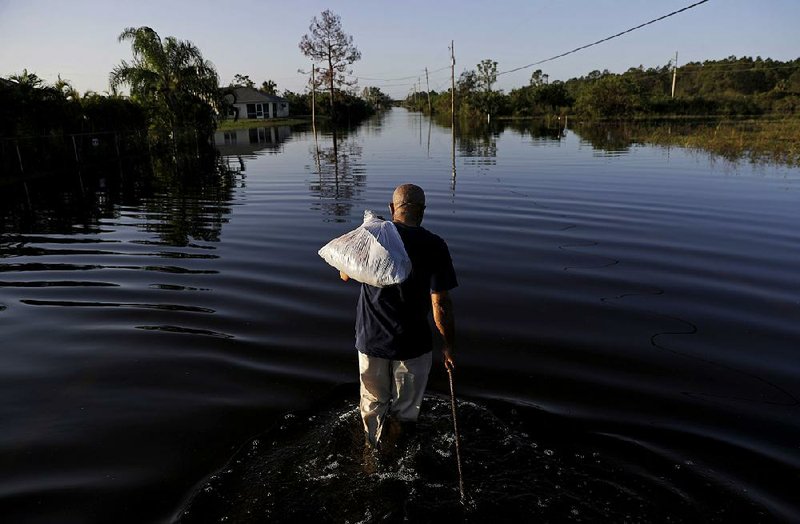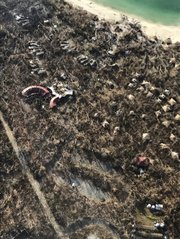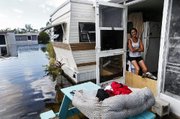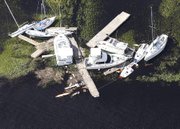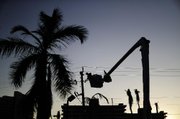LOWER MATECUMBE KEY, Fla. -- With one-fourth of the homes in the Florida Keys feared destroyed, emergency workers Tuesday rushed to find Hurricane Irma's victims -- dead or alive -- and to deliver food and water to the island chain.
As crews labored to repair the only highway connecting the Keys, residents of some of the islands closest to Florida's mainland were allowed to return home and get their first look at the devastation.
"It's going to be pretty hard for those coming home," said Petrona Hernandez, whose concrete home with 35-foot walls on Plantation Key was unscathed, unlike others a few blocks away. "It's going to be devastating to them."
Because of disrupted phone service and infrastructure damage, the full extent of the destruction remained a question mark more than two days after Irma roared into the Keys with 130 mph winds.
Click here for larger versions
Photos by The Associated Press
Photos by The Associated Press
Elsewhere in Florida, life inched closer to normal, with some flights again taking off from airports, many curfews lifted and theme parks reopening. Cruise ships that extended their voyages and rode out the storm at sea began returning to port with thousands of passengers.
The city of Miami Beach, one of many evacuated as Irma approached, reopened Tuesday morning for residents to return home, although people were warned to be careful amid fallen trees and downed power lines.
Thousands of people hit the roads, headed back to their homes. Travelers, as well as traffic maps, social media posts and gasoline trackers reported gridlock on many main roads.
"As soon as we hit the state line, it was traffic jams and accidents," said Elizabeth Priore of Fort Lauderdale, as she headed home Tuesday afternoon from Alpharetta, Ga.
The number of people without electricity in the steamy late-summer heat dropped late Tuesday to about 10 million -- half of Florida's population. Utility officials warned that it could take 10 days or more for power to be fully restored. About 110,000 people remained in shelters across Florida.
The number of Florida deaths blamed on Irma climbed to 12. Four deaths were reported in South Carolina and two in Georgia. At least 37 people were killed in the Caribbean.
"We've got a lot of work to do, but everybody's going to come together," Florida Gov. Rick Scott said. "We're going to get this state rebuilt."
In Jacksonville, the extent of the flooding -- driven by the hurricane's storm surge, heavy rains and high tides -- "shocked" residents and officials alike, the governor said. "So many areas that you would never have thought have flooded have flooded," he said.
Jacksonville, with 1.5 million people in its metropolitan area, is bisected by the St. Johns River and is heavily built up along its banks. Capt. Raymond Lutzen, 48, a Jacksonville firefighter on the region's Urban Search and Rescue Team, said that when the river swells and the city's storm drains clog, "it's like a bathtub with a plug in."
In Naples, on Florida's southwest coast, more than 300 people stood outside a Publix grocery store Tuesday morning, waiting for it to open.
A manager occasionally appeared at the store's sliding door, providing progress reports. One time, he said store workers were throwing out produce that had gone bad. Another time, he said workers were trying to get the cash registers working.
At the front of the line after a more-than-two-hour wait, Phill Chirchirillo, 57, said days without electricity and other basics were beginning to wear on people.
"At first it's like, 'We're safe, thank God.' Now they're testy," he said. "The order of the day is to keep people calm."
DAMAGE OUTSIDE FLORIDA
Irma's rainy remnants pushed northwest through Alabama and Mississippi after drenching Georgia. Flash-flood watches and warnings were issued around the Southeast.
The extent of property damage in the Southeast still wasn't known Tuesday.
Tybee Island, Ga., Mayor Jason Buelterman estimated that several hundred homes had flooded in his community, including roughly 200 houses that also took in water during Hurricane Matthew, which caused $500 million in damage.
While Matthew's destruction was largely confined to coastal areas, Irma left a much wider path of damage. Tropical storm winds stretched more than 400 miles from the storm's center, toppling trees onto homes and power lines across a large inland area.
"Statewide we're going to have more [insurance] claims than we did with Matthew," said Jay Florence, Georgia's deputy insurance commissioner. "But they're going to be most acute on the coast."
The storm's passing also left many Georgians without electricity. More than 894,000 Georgia Power and Electric Membership Corp. customers were in the dark Tuesday afternoon.
Georgia Power spokesman Swann Seiler said fewer outside resources were available to help in Georgia because of massive efforts to restore electricity in storm-battered Florida and Texas. She said Georgia customers should be prepared to wait several days.
Alabama Power reported 20,000 customers without electricity Tuesday morning. No major storm damage was reported in Alabama.
Irma's remnants forced Hartsfield-Jackson Atlanta International Airport, the world's busiest passenger airport, to cancel nearly 200 flights early Tuesday. That raised the total number of flights Irma interrupted to about 1,300, Atlanta airport spokesman Andrew Gobeil said.
Georgia Gov. Nathan Deal lifted an evacuation order Tuesday for nearly 540,000 coastal residents. He cautioned that recovery in his state could take a while because the storm affected the entire state.
"We have not had one like this in the state of Georgia for a long time," Deal said.
In South Carolina, Gov. Henry McMaster counted his state's blessings, even as he mourned the four deaths there from the storm. There were still more than 100,000 customers without power in the state Tuesday afternoon.
"We are very happy the hurricane went someplace else -- the main force of it," McMaster said Tuesday in what he planned to be his last briefing on Irma.
In North Carolina, the storm toppled trees that blocked some mountain roads, and tens of thousands of people were without power, but Gov. Roy Cooper said most problems in the state should be resolved by today.
In Georgia, a man was killed when a tree fell on his house, and a woman died after a tree fell on a vehicle in which she was riding. The dead in South Carolina included a man struck by a tree limb while clearing storm debris and a man who died of carbon monoxide poisoning from a generator inside his mobile home.
RUIN IN THE KEYS
While the 400-mile-wide storm engulfed nearly all of Florida, the Keys -- home to about 70,000 people -- appeared to be the hardest hit. Drinking water and power were cut off, all three of the islands' hospitals were closed, and the supply of gasoline was severely limited.
Search-and-rescue teams made their way into the more distant reaches of the Keys, and an aircraft carrier was positioned off Key West to provide assistance. Officials said it was not known how many people ignored evacuation orders and stayed behind in the Keys.
Monroe County, whose county seat is Key West, began setting up shelters and food-and-water distribution points for Irma's victims in the Keys.
Crews also worked to repair two washed-out, 300-foot sections of U.S. 1, the highway that runs through the Keys. They also began to check the soundness of the 42 bridges that link the islands.
Federal Emergency Management Agency administrator Brock Long said preliminary estimates suggested that 25 percent of the homes in the Keys were destroyed and 65 percent had major damage.
"Basically every house in the Keys was impacted," he said.
In the Keys' Islamorada, a trailer park was devastated, the homes ripped apart as if by a giant claw. A sewagelike stench hung over the place.
Everywhere there was scattered debris, including refrigerators, washers and dryers, a 25-foot fishing boat and a Jacuzzi. Homes were torn open providing a glimpse inside, including a bedroom with a small Christmas tree decorated with starfish.
One man and his family arrived to check on their weekend home and found it destroyed. The sight was too much to bear. The man told his family to get back in the car, and they drove off toward Miami.
Authorities stopped people and checked for documentation, such as proof of residency or business ownership, before allowing them into the Upper Keys, including Key Largo, Tavernier and Islamorada.
The Lower Keys -- including the chain's most distant and most populous island, Key West, with 27,000 people -- were still off-limits, with a roadblock in place where the highway was washed out.
In Lower Matecumbe Key, just south of Islamorada, Donald Garner, 57, checked on his houseboat, which had only minor damage. Nearby, three other houseboats were partially sunk. Garner had tied his boat to mangroves before the storm.
"That's the only way to make it," said Garner, who works for a shrimp company.
While the Keys are studded with mansions and beachfront resorts, about 13 percent of the people live in poverty and face big obstacles as the cleanup begins.
"People who bag your groceries when you're on vacation, the bus drivers, hotel cleaners, cooks and dishwashers, they're already living beyond paycheck to paycheck," said Stephanie Kaple, who runs an organization that helps the homeless in the Keys.
Corey Smith, a UPS driver who rode out the hurricane in Key Largo, said it was a relief that many buildings on the island escaped major damage. Still, he said, conditions there were not good, with branches blocking roads and supermarkets closed.
"They're shoving people back to a place with no resources," he said by telephone. "It's just going to get crazy pretty quick."
Information for this article was contributed by Jason Dearen, Martha Mendoza, Terry Spencer, Gary Fineout, Jonathan Mattise, Joe Reedy, Jay Reeves, Terrance Harris, Claire Galofaro, Freida Frisaro, Jennifer Kay, Curt Anderson, David Fischer, Russ Bynum, Jonathan Landrum Jr., Kim Chandler, Seanna Adcox, Kate Brumback and Bill Barrow of The Associated Press; by Jess Bidgood, Emily Cochrane and Dana Goldstein of The New York Times; and by Mark Berman, Katie Zezima, Brian Murphy, William Wan, Angela Fritz, Sandhya Somashekar, Darryl Fears, Perry Stein, Joel Achenbach, Patricia Sullivan, Lori Rozsa, Dustin Waters and Scott Unger of The Washington Post.
RELATED ARTICLES
http://www.arkansas…">French president, Dutch king visit storm-socked islandhttp://www.arkansas…">Marriott-hired ferry leaves nonguests on dock
A Section on 09/13/2017
